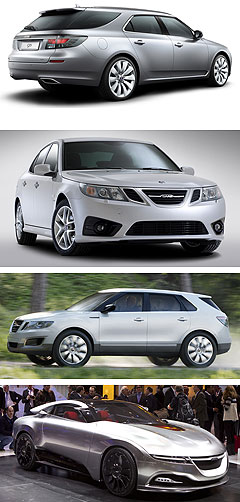Saab bidders ‘still want part of the business’
BY RON HAMMERTON | 11th Apr 2011

Saab Cars Australia managing director Stephen Nicholls said some of the bidders who lost out to Dutch sportscar company Spyker Cars in the deal done early last year still want a piece of the Saab action.
“When Saab was put up for sale, we had about 32 or 33 tenders from organisations interested in buying Saab,” he said at last week’s Saab 9-5 media launch in Victoria.
“Some of those such as Koenigsegg and Spyker you know about (but) there were some Chinese companies, American companies – all over the world.
“Not all of them have gone away, and some are still interested to get back in and share some of the Saab business.”Mr Nicholls said he did not know which companies were the leading contenders to share the “9-1 or 92 or whatever it is going to be called”.

He said the only agreement Saab had signed with another car company to date was the deal for BMW to supply a 1.6-litre petrol engine for the next 9-3 due at the end of 2012.
“That’s the limit of the co-operation at the moment, but we do have a number of people who want to carry on talking with us about potential, further co-operations,” he said.
Saab’s brand design chief Simon Padian, who also attended the launch, cautioned that the new small car was still not officially in the company’s business plan, but was “on top of everyone’s wish list”.
The British-born designer, who has worked for Saab in Sweden for 20 years, said the development time for such a car would be three to four years.
This suggests that the rumoured 2014 launch date for the new sub-9-3 baby of the range – an Audi A1 competitor – could be right, provided Saab can seal the deal with a development partner relatively soon.
It is unclear if the ‘92’ – for which new Saab Automobile chairman Victor Muller has taken a personal interest, even submitting his own tear-drop-shaped sketch inspired by Saab’s original 1949 92 – would be built on Saab’s new flexible platform that will underpin the new 9-3 from next year and subsequent models.
Some Swedish reports suggest the Saab platform will have sufficient flexibility to stretch all the way from a small car – the 92 – to an all-new flagship above the 9-5, dubbed 9-7.
Mr Padian denied that the new platform in its entirety underpinned the hybrid PhoeniX concept car shown at last month’s Geneva motor show, saying it only contained elements of it.
“Obviously, that (PhoeniX) is a one-off concept car,” said the design chief. “Platform-wise, there is a platform that exists. You shouldn’t confuse the two necessarily. They share a lot of technologies.”Mr Padian confirmed that the new-generation 9-3 – due next year as the first all-new model designed under the independent Saab – would be built on that platform.
He indicated the design of the new 9-3 would draw on elements of both the new 9-5 and the PhoeniX concept car as Saab pursued its new design direction that would be partly inspired by a mix of Scandinavian design and the company’s roots, particularly its aircraft heritage.
“The aircraft heritage is something that is pretty unique to us, in combination with the other elements,” he said.
“It is obviously something we want to project and communicate so that everybody can see that ‘yeah, OK, this is a Saab – they are the guys that started off building aircraft’.
“It is just a great way to establish a unique identity and project the values of the brand.”Mr Padian promised the future Saab design language would, like the PhoeniX, add a little more emotion and colour.
The arrival of the third-generation 9-3 in Australia towards the end of 2012 would spell the end of the old Saab range in this country.
By then, the new 9-5 sedan flagship that arrived in showrooms last week will be the oldest car on the books.
The 9-5 sedan will be joined in about October by the forthcoming 9-5 SportCombi wagon – which might be called Estate in Australia – and the 9-4X mid-sized SUV either late this year or early 2012.
Like the 9-5, the 9-4X is built on a GM platform, but while 9-5 rolls off the Saab production line in Trollhattan, Sweden, the 9-4X is made alongside the Cadillac SRX at a GM plant in Mexico.
The 9-4X will be followed in late 2012 by the 9-3 range, with the ‘92’ – provided it gets the tick of approval – arriving in about 2014.
Apart from the GM-built 9-4X, all future Saab models are expected to be made at Trollhattan, with cars that were previously built elsewhere – such as the Saab 9-3 Convertible that was made under contract by Magna Steyr in Austria – returning to a central base in Sweden.
According to Swedish reports, Saab also is offering to build cars under contract for another car-maker to help it achieve its full 190,000-vehicles-a-year capacity for greater efficiency, with the shared small car the most likely contender.
Meantime, the current Saab 9-3, which continues in Australian showrooms in sedan, convertible, SportCombi and 9-3X wagon guises, will have one last hurrah later this year with the arrival of facelift dubbed Griffin, in honour of Saab’s corporate emblem.
The updated range will be offered in all of the current body styles, but with styling and mechanical tweaks to help the second-generation 9-3 through to the arrival of the all-new car a year or so later.
| What's coming fromSaab: | |
| All-new 9-5 sedan | April |
| 9-5 SportCombi | October |
| 9-3 facelift | Q4 |
| 9-4X | Q4 |
| All-new 9-3 | 2012 |
| All-new 92 | 2014 |